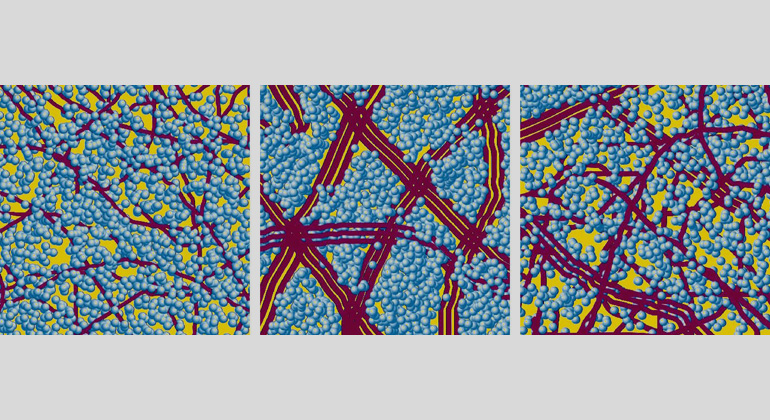X-ray vision reveals how polymer solar cells wear out
Scientists from the Technical University of Munich have used the acurate X-ray vision provided by DESY’s radiation source PETRA III to observe the degradation of plastic solar cells.
Their study suggests an approach for improving the manufacturing process to increase the long-term stability of such organic solar cells. The team of Prof. Peter Müller-Buschbaum has presented its findings in the latest issue of the scientific journal Advanced Energy Materials (Vol. 6, No. 19, published online in advance).
Unlike conventional solar cells, which are made of silicon, organic solar cells produce electricity in an active blended layer between two carbon-based materials. When one of these is a polymer, the resulting cell is often referred to as a plastic solar cell. These are particularly promising because they can be manufactured simply and cheaply. They can be used to make extremely lightweight, flexible and even semi-transparent solar cells using printing techniques on flexible polymer materials, opening up completely new fields of application. In general, however, organic solar cells are less efficient than silicon-based ones, and sometimes they have also a reduced lifetime.
The internal structure of the active layer is crucial in organic solar cells. When manufacturing them, the two materials that form the active layer have to separate out of a common solution, much like droplets of oil forming in water. “It is important that the polymer domains formed in the process are a few tens of nanometres apart,” points out Christoph Schaffer, a PhD student in Müller-Buschbaum’s group, who is the paper’s first author. “Only then positive and negative charge carriers can be efficiently produced in the active layer and separated from each other. If the structure is too coarse or too fine, this process no longer happens, and the efficiency of the solar cell will decrease.” A nanometre is one millionth of a millimetre.
Modern polymer solar cells often consist of so-called low-bandgap polymers, which absorb particularly large amounts of light. In many cases, these require the use of a solvent additive during the manufacturing process in order to achieve high efficiencies. However, this additive is controversial because it might further decrease the lifetime of the solar cells.
The scientists used DESY’s X-ray source PETRA III to study the degradation of such low-bandgap polymer solar cells with solvent additives in more detail. To this end, a solar cell of this type was exposed to simulated sunlight in a chamber, while its key parameters were continuously monitored. At the same time, the scientists shone a narrowly collimated x-ray beam from PETRA III at the solar cell at different times, providing a picture of the internal structure of the active layer on a nanometre scale every few minutes. “These measurements can be used to relate the structure to the performance of the solar cell and track it over time,” explains co-author Prof. Stephan Roth, who is in charge of DESY’s P03 beamline, where the experiments were conducted.
“The data reveals that domains that are on the scale of a few tens of nanometres shrink substantially during operation and that their geometric boundaries with other components disappear,” says Schaffer. At the same time, the measurements suggest that the amount of residual solvent additive decreases. The scientists attribute the measured drop in the efficiency of the solar cell to the observed decrease.
“Since there is evidence to suggest that the residual amount of solvent additive decreases, we have to assume that this process can limit the lifetime of the solar cells,” explains Müller-Buschbaum. “Therefore it is essential to come up with strategies for stabilising the structure. This could be achieved through chemical bonding between the polymer chains, or using customised encapsulating substances.”
In an earlier study, the Munich researchers observed the degradation of a different type of polymer solar cell. In that case, the efficiency was found to drop as a result of the active centres gradually growing in size during their operation. This suggested that it is in fact better to manufacture such solar cells with a suboptimal structure, i.e. one that is too fine, so that it can then grow to the optimum size during the first hours of operation.
The current study picks up the story where the previous one left off. “Our first study showed us that the efficiency dropped when the structure became coarser,” says Schaffer. “Exactly the opposite happens in the present study. This behaviour is precisely what we expected, because the composition of the active layer is different. The materials in the first study tend to demix to a high degree. Here, the opposite is true, and we need the solvent additive in order to achieve the demixing of the materials that is needed to obtain high efficiencies. When the solvent additive disappears during operation, the structure becomes finer and therefore moves away from its optimum.”
Both these studies offer important approaches to optimising the manufacture of organic solar cells, as co-author Roth points out: “The way these two studies fit together provides a wonderful example of how investigations with synchrotron radiation on the atomic scale yield crucial results, especially in applied research such as in the field of renewable energies.”
Reference:
Morphological Degradation in Low Bandgap Polymer Solar Cells – An In Operando Study; Christoph J. Schaffer, Claudia M. Palumbiny, Martin A. Niedermeier, Christian Burger, Gonzalo Santoro, Stephan V. Roth, and Peter Müller-Buschbaum; Advanced Energy Materials, 2016; DOI: 10.1002/aenm.201600712
Source
Deutsches Elektronen-Synchrotron – A Research Centre of the Helmholtz Association 2016








